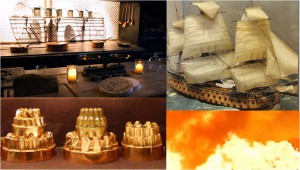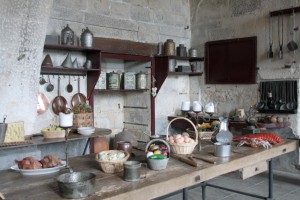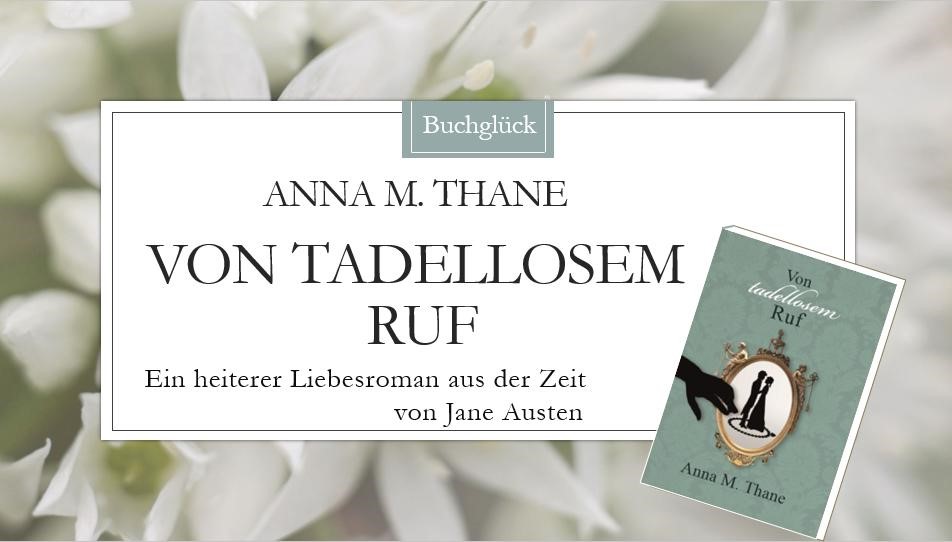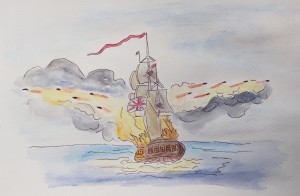 Our modern world was born in the 18th century. Numerous inventions, ideas and concepts developed during the Romantic Age can still be found in our everyday life. In the previous part of this series I had presented roller skates, the steel pen and the financial instrument ‘pfandbrief’ as brainchildren of the 18th century. Today, we discover how a chef and a baronet shaped our world.
Our modern world was born in the 18th century. Numerous inventions, ideas and concepts developed during the Romantic Age can still be found in our everyday life. In the previous part of this series I had presented roller skates, the steel pen and the financial instrument ‘pfandbrief’ as brainchildren of the 18th century. Today, we discover how a chef and a baronet shaped our world.
Eat, Cook, Love: Revolution in the Kitchen
 The French Revolution shook the world in 1789. With the abolition of the nobility in France, lifestyle and taste of the aristocrats came under pressure, too. A young, ambitious cook, Marie-Antoine Carême (1784 – 1833), changed the traditional way of cooking to a new, lighter and more bourgeois style:
The French Revolution shook the world in 1789. With the abolition of the nobility in France, lifestyle and taste of the aristocrats came under pressure, too. A young, ambitious cook, Marie-Antoine Carême (1784 – 1833), changed the traditional way of cooking to a new, lighter and more bourgeois style:
- He discarded the heavy spices that were fashionable in those days and opted for new seasonings such as salt, pepper, parsley, thyme and bay leaf.
- He abolished the combination of fish and meat on the same plate and the usage of offal and cockscomb to garnish food. Carême used meat to garnish meat, and fish to garnish fish.
- He classified French sauces into four groups.
- He introduced the double-breasted kitchen jackets and the tall hats for chefs and the caps for cooks still worn in professional kitchens today.
- He made white the colour of kitchen uniforms. White indicated cleanliness.
Carême worked for distinguished persons such as the French diplomat Talleyrand, the Rothchilds, Napoleon, the Prince of Wales and the Russian Zsar – and their prominent guests. Therefore his influence on cooking was enormous. He is credited with nothing less than founding the Grande Cuisine Française that established the supremacy of French cooking in Europe for the past 200 years.
From Mysore with Love: Revolution in Warfare
Rockets have existed as weapons in Asia since a long time, and the technique was familiar to Europeans since the 17th century. However, Indian rulers of the Kingdom of Mysore invented a new, effective version when they had to fight against the British in the 1790ies.
Hyder Ali, prince of Mysore, and his son, Tipu Sultan, created rockets with metal cylinders that contained the combustion powder (the cylinders were previously made from paper). This enabled higher thrust and longer range for the missile.
The British encountered the terrifying new weapon in the battles of Seringapatam and quickly tried to copy it. Several ‘Mysore rockets’ were sent to England for research. It was William Congreve (1772 –1828), army officer and baronet, who refined the weapon and came up with the even more effective ‘Congreve rocket’:
- He prepared a new propellant mixture,
- developed a rocket motor with a strong iron tube with conical nose,
- and fixed the stick of the rocket in the centre instead of at the side of the rocket, thus reducing drag and enabling the weapon to be fired more accurately.
After some years of experimenting, he had created a rocket that could travel 1,500 yards (1.4 km), and by 1806 his rockets reached a range of 3,000 yards (3.8 km).
The navy was impressed and converted the warships HMS Galgo and HMS Erebus into rocket ships. The Congreve rocket had its debut in 1806 in a battle at Gaeta, near Naples, where the British assisted the Kingdom of Naples and Scilly in their struggle against the French.
The army was reluctant to try the new weapon. A field trial of the Congreve rocket in 1810 failed in the presence of Arthur Wellesley, then Viscount Wellington. It was only in 1811 that the Royal Artillery committed itself to use the Congreve rocket.
Wellington remained averse to rockets. Nevertheless the Congreve rocket was part of the Peninsular Campaign at the Battle of Toulouse in April 1814 and of the Battle of Waterloo in 1815. From then, the use of military rockets spread throughout the western world, making war more terrible and devastating than ever.
Related topics
- The Origin of Now: Part 1
- Fashion Meets Scientific Progress: The “Spy Fan”
- The Girl, the Kite and the Eccentric Inventor
- Captain Stanhope’s Invention: A Carriage for ‘The Ton’
- A Traditional Craft: Making Watercolour-Paper
Sources
- Kelly, Ian: Cooking For Kings, The Life of Antonin Carême, The First Celebrity Chef; Walker & Company, 2003.
- http://www.cooksinfo.com/marie-antoine-careme
- https://en.wikipedia.org/wiki/Richard_Bogue
- https://en.wikipedia.org/wiki/Congreve_rocket#Early_Indian_rockets
- https://en.wikipedia.org/wiki/History_of_rockets#Spread_of_rocket_technology
- https://en.wikipedia.org/wiki/Mysorean_rockets
- https://en.wikipedia.org/wiki/Congreve_rocket#Use_of_Congreve_rockets
Article by Anna M. Thane, author of the novel
“Von tadellosem Ruf” (http://amzn.to/2TXvrez)


